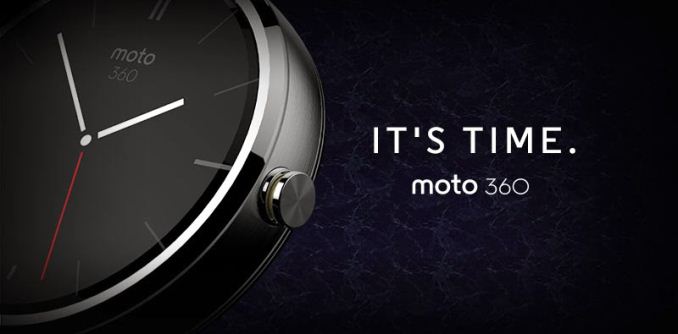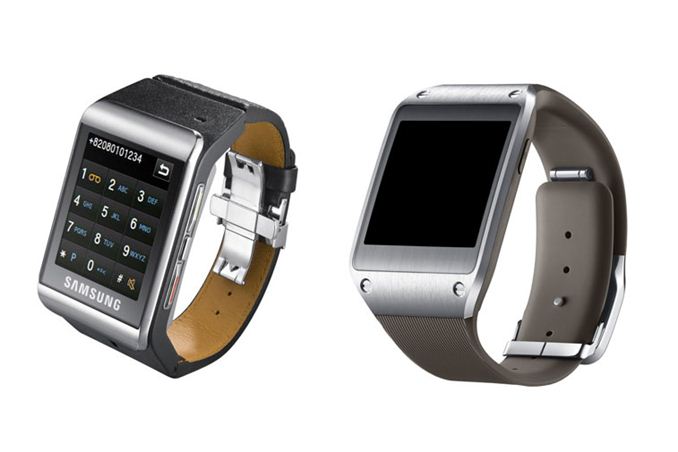Android Wear, Moto 360, and LG G Watch: Initial Thoughts
by Joshua Ho on March 18, 2014 9:53 PM EST
Google has finally announced its entrance into the smartwatch segment with the platform Android Wear. Much like how Android is a broadly adopted platform by many smartphone OEMs, Google hopes to have the same level of adoption with Android Wear. At its most basic level, Android Wear will be centered upon Google Now, which is a way of presenting predictive information in a card format. It will also serve as a touchless control device like the Moto X for voice searches, along with notifications and the abAndrility to act on specific notifications without taking out a phone, such as dictating a text message. If this sounds somewhat familiar, that’s definitely not unusual, because that’s exactly what Google Glass is for. An example of the notification system and the touchless controls can be seen below.


Android Wear isn't just borrowing the Android brand name either, it seems that Android Wear is actually based on Android proper. The big part that Google hopes developers will use is the Wear SDK, which allows for custom UIs, sensor data collection, communication between wearable and phone, and hooking into the touchless control feature.
What is different is the social factor. While Glass is extremely obvious and relatively unacceptable to society due to potential privacy implications, an Android Wear smartwatch wouldn’t have such issues because a camera or video on a watch would be quite conspicuous. While this makes it much easier to see mass-market adoption of smartwatches, the lack of heads-up display functionality removes many of the killer applications that Glass had, such as the potential for live video streaming and navigation without taking ones’ eyes off the road. It’s hard to say whether this would mean that the case for a smartwatch is tough to swallow, but in the interim, such a formfactor is ideal.

The elephant in the room is why Google is doing this. Ultimately, no one has really figured out how to best implement the smartwatch, and when the vast majority of people seem to expect budget prices on these accessories, it speaks to the perceived utility and value of such accessories. Despite this, Google is pushing on, and I’m convinced that this is the product of a burning desire to maintain the exponential growth that the smartphone market once had, as products like the Moto G are signaling a new era of dramatically depressed profit margins, greatly lengthened upgrade cycles, and OEM consolidation. This mirroring of the PC industry is likely the strongest reason why Google and its hardware partners are now moving to wearables. The other key reason is that Google wants to have the first-mover advantage in case wearables take off, a clear case of learning from past experiences in the smartphone space. The fact that it's now physically possible to have sufficient compute for a usable smartwatch explains the timing as well.
Of course, it’s worth looking at the sorts of designs already announced. The first one that we knew of was announced back in MWC at the Motorola press conference, but now we’ve seen the first images of the actual watch, dubbed the Moto 360, and it’s clear that Motorola understands that the most important part of the watch component has to be industrial design/material feel. While the circular display is undoubtedly more expensive, it’s definitely important as it helps to make the watch actually feel like a watch.

The more traditional smartwatch would be the LG G Watch, which is said to be aimed at creating a low barrier to entry for developing on the Android Wear platform, which parallels the Nexus lineup for Android smartphones and tablets. Neither the LG G Watch nor the Moto 360 have any specific details for the display, SoC, RAM, or any other specifications, but it’s not a stretch to say that these would be running low power CPU cores with 512MB of RAM or less, with display resolutions solidly below VGA (640x480), based upon the size of the display that can be reasonably fitted on a watch for normal wrists.
Ultimately, it’s hard to say whether this will be an enduring trend or a passing fad. I’m reminded of early smartphones, which were often not very well polished as most OEMs had not yet figured out the right formula for solid usability. After all, a watch has generally been for fashion, while phones have always been tools first.










30 Comments
View All Comments
Broken - Wednesday, March 19, 2014 - link
I am all over that Moto 360. Finally a classy smart watch. Reminds me of the old Sony(fossil) smart watch a little. Hopefully it lasts a couple days on a charge.uhuznaa - Wednesday, March 19, 2014 - link
I would never call something classy that I have only seen in renderings.I'm also not sure if aping a watch is the most clever thing to do for wearable tech. Do Smartphones look like cellphones with added features? Well, the first smartphones certainly did, but they weren't exactly a hit.
teiglin - Wednesday, March 19, 2014 - link
The watch is a mature market of jewelry, and when smartphones were introduced, they did look just like other cell phones (I had a Windows Mobile flip phone for a while in college). I'm not saying there is no market for different-looking smartwatches, but the look of Gear and the G Watch call to mind the hideous calculator watch I wore when I was 10. Obviously some people buy them regardless, or at least in spite, of their appearance, but I would argue that the idea that a watch is a fashion accessory is embedded in the consumer consciousness in a way that has no equivalent in the relatively-nascent smartphone space. Certainly people have begun to view smartphones more and more that way, but it is still standard fare to see people with a black slab and that is okay for a phone; using an ugly phone does not bring social judgment upon someone the way wearing an ugly watch will.name99 - Wednesday, March 19, 2014 - link
Why does the fact that the watch WAS an item of jewelry mean that future wearables have to be the same? [And isn't it strange that the people who go on about this the most are the same people who criticize Apple fans for buying based on "fashion"? I'm an Apple fan, but I wear the cheapest Timex watch I could find at Target that offers the particular set of functionality I want.]The watch as fashion item is a historical weirdness; it has nothing to with the future, there is nothing INTRINSIC about it.
(a) If you don't like watches, then don't call it a watch. Call it a duoscreen. Call it a wristman. Call it an iBand.
(b) The world is full of things that we were told would never be popular because they were "too dorky", from the first cell phones to bluetooth headsets. I expect that, yes, people who obsess about their appearance, will not be the first people to use these devices. Which means precisely nothing.
There are plenty of people who WILL use them, and as their value and usefulness is increased, the popularity will increase. Walkman's were a dorky niche item, which when they became iPods became less dorky and less niche. A businessman would never have worn a Walkman around work, but wearing a BT headset around work is hardly unusual...
solipsism - Wednesday, March 19, 2014 - link
"Wearables" have been around since dawn of man and despite some obvious practical uses they are all deeply intertwined with fashion. I think it's unreasonable to assume that a movement into electronic wearables are going to start a new revolution of being purely practical objects.Dentons - Wednesday, March 19, 2014 - link
This could spell the death of Firefox OS.Yes, it's for wearables, not phones. Firefox OS's only remaining selling point is its low hardware requirements. This should match or beat those. Chinese OEM's won't hesitate to scavenge this codebase for their cheap, developing world, Android phones.
Conficio - Wednesday, March 19, 2014 - link
I don't think so, isn't this only driving the UI and some sensors and a connection to the phone. It needs still a phone in your pocket to execute the rest of the features a smart phone has (Phone, GPS, ...)StargateNH - Wednesday, March 19, 2014 - link
I wont be happy if I have to charge these daily. Enough to NOT buy one if thats the case...but I want one so bad!Homeles - Wednesday, March 19, 2014 - link
Fortunately, that's something that will go away as a function of time. In particular, when SoCs are moved to FinFET processes, we should see some healthy jumps in battery life. Displays are always getting better too. It's also a relatively new form factor, and we'll see things improve as time goes on.name99 - Wednesday, March 19, 2014 - link
This is why I think the SUCCESSFUL versions of these (in particular Apple's version) will NOT feature a full OS and robust core. The power requirements are too high, the extra functionality is too low. It makes far more sense to put EVERYTHING that doesn't have to be on the wrist on the phone. The wrist has display, sensors, BT LE, and a minimal core, minimal OS, minimal memory, nothing else.Yes, there'll be whining from the usual idiots, but catering to these people has been a guaranteed money loser in the past. The company that wins in this space will be the one that gets battery life right, not the one that offers the biggest SDK.